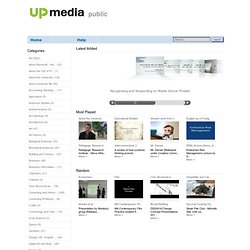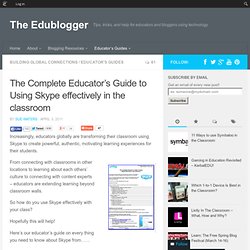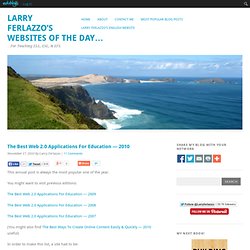

eLearning Blog Dont Waste Your Time - eLearning, mLearning, Web 2.0, Blogging and the stuff in between.
Social media has evolved into the art of storytelling, and we must all become masters of it. Personal Learning Networks. 30+1 Ways You Should Be Using Facebook in Your Classroom « Magic in education! Social media in education. Latest Added Most Played Pedagogic Research Institute - Steve Whe...

A review of how systemic thinking promot... Mr. Darwin [Released under Creative Comm... Enterprise Risk Management Lecture by S... Random Presentation by Monika's group [Release... MA Contemporary Film Practice student fi... DSGN143 Design Concept Presentations 201... Steak Pak Choi - Michelin Star chef Ja... The Complete Educator’s Guide to Using Skype effectively in the classroom. Increasingly, educators globally are transforming their classroom using Skype to create powerful, authentic, motivating learning experiences for their students.

From connecting with classrooms in other locations to learning about each others’ culture to connecting with content experts – educators are extending learning beyond classroom walls. So how do you use Skype effectively with your class? Hopefully this will help! Here’s our educator’s guide on every thing you need to know about Skype from…… 1. Setting up your account A. 2. A. » Top Tools 2011 C4LPT. The 35 Best Web 2.0 Classroom Tools Chosen By You. 100 Web 2.0 Tools Every Teacher Should Know About 44.24K Views 0 Likes We're always trying to figure out the best tools for teachers, trends in the education technology industry, and generally doing our darnedest to bring you new and exciting ways to enhance the classroom. But I wanted t... 20 Free and Fun Ways To Curate Web Content 23.98K Views 0 Likes What's the best way to organize it all into at least some reasonable manner?
Larry Ferlazzo’s Websites of the Day… - The Best Web 2.0 Applications For Education — 2010. This annual post is always the most popular one of the year.

You might want to visit previous editions: The Best Web 2.0 Applications For Education — 2009 The Best Web 2.0 Applications For Education — 2008 The Best Web 2.0 Applications For Education — 2007 (You might also find The Best Ways To Create Online Content Easily & Quickly — 2010 useful) In order to make this list, a site had to be: * accessible to English Language Learners and non-tech savvy users. * free-of-charge. * appropriate for classroom use. * completely browser-based with no download required. It’s possible that a few of these sites began in 2009, but, if so, I’m including them in this list because they were “new to me” in 2010.
You might also be interested in exploring the 530 other “The Best…” lists that I’ve posted over the past three years. Finally, you might also want to subscribe to this blog for free. Here are my choices for The Best Web 2.0 Applications For Education — 2010: Meeting Words Titan Pads. Engaging Students with Engaging Tools (EDUCAUSE Quarterly. Key Takeaways A new course teaching media, mass communication, and political identities in the Middle East and North Africa explored the use of social media in pursuit of effective learning. Using a variety of social media and other tools encouraged student engagement in and out of the classroom. Student responses varied from discomfort with the technology to enthusiastic adoption and continued use after the course ended. This article records my experiences teaching a new course in early 2009 at Dickinson College, a four-year liberal arts college in Pennsylvania serving around 2,300 undergraduates. The course emphasized newer and emerging media and technologies such as satellite television, the Internet, and mobile telephony.
In a class of 21, there was naturally a range of responses to the different technologies used, from enthusiastic embrace through indifference to active resistance. Course and Instructor Preparation The course aimed to address two questions:
Technologically Externalized Knowledge and Learning. Let’s take a step back and consider how well we are using learning technology in contrast with what is possible given advances over the last decade. Ideologies influence design, then design constrains future options. We don’t have to look very far to see examples of this simple rule: classrooms, design of organizational work activities, politics, and the operation of financial markets. What we create to survive during one era serves as neurosis for another. In education – particularly in technology enhanced education – a similar trailing of ideologies from another era is observed. For example, education consultants and speakers commonly declare “if a student from 100 years ago came to our classrooms, she would feel right at home”.
What are the ideologies reflected in this approach to learning? 1. Other ideologies exist, but these are particularly influential in education, impacting design to accreditation. What is wrong with these views? The externalized generation… 1. Articles in alphabetical order - Educational Technology.
Instructional Design. Impact, Evidence and Evaluation. Social media.